Oaxaca is a nice enough town. The capital of the state of Oaxaca, it sits
nestled in a highland valley, surrounded by the Sierra Madres. It is also a
big town. It took me 15 minutes just to ride from the outskirts to my hotel,
Villa Alta. Not surprisingly, in the center of town is a large and beautiful
cathedral.
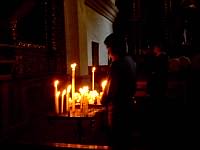 In the center of town was also something that had been foreign to me for the
past week - foreigners. Not once in my journey from Toluca did I encounter a
gringo; now I was surrounded by them. It was a bit of a culture shock. I
found myself spending a lot of time away from the center, where all the locals
hung out. I guess I was just in denial of my gringoness. I found the locals
much more fun to socialize with. Out on the periphery of town I also found a
favorite internet cafe, where I was to spend many hours hacking. Unlike the
ones in town center, which usually had one computer with a handful of tourists
waiting to use it, this place was almost empty, with just a couple of locals on
Latinchat. Not having the sophistication we have in the states to use the net
to send high quality jokes and cookie recipies to a few close friends, Mexicans
resort to flirting in Spanish chat rooms. I would just do my usual routine of
cursing ans swearing as I tried to edit files thousands of miles away.
In the center of town was also something that had been foreign to me for the
past week - foreigners. Not once in my journey from Toluca did I encounter a
gringo; now I was surrounded by them. It was a bit of a culture shock. I
found myself spending a lot of time away from the center, where all the locals
hung out. I guess I was just in denial of my gringoness. I found the locals
much more fun to socialize with. Out on the periphery of town I also found a
favorite internet cafe, where I was to spend many hours hacking. Unlike the
ones in town center, which usually had one computer with a handful of tourists
waiting to use it, this place was almost empty, with just a couple of locals on
Latinchat. Not having the sophistication we have in the states to use the net
to send high quality jokes and cookie recipies to a few close friends, Mexicans
resort to flirting in Spanish chat rooms. I would just do my usual routine of
cursing ans swearing as I tried to edit files thousands of miles away.
I spent the entire morning of my first day in Oaxaca in the market, trying
to convince little old women selling vegetables to let me take their pictures.
Markets have always been a favorite of mine, and through experience I have
learned that the more you talk to someone, thw worse the picture eventually
turns out. Still, I find myself chatting it up a lot. I spent well over an
hour with one woman and her daughter, watching her haggle with old birds over
the price of, well, some leafy vegetable that I don't know the name of.
Eventually, I bought them sodas, and headed into town.
In the next market, I was enchanted by one hallway, with a tall, vaulted
roof, where meat was being sold. The hallway was dark, except for a sheet of
light which came through a gap in the roof, lighting the swirling smoke from
the wood burning grills. It was very, well, pituresque, and I spent an entire
roll trying to capture it. The women at the food stall near me laughed as I
looked at their butchery meats, smoke, and dim light in awe, but they assured
me that my photographing was not disturbing them. One woman, who was working
down the hall, and whom I never even photographed, apparently was not too
pleased by my presence. As I sat and ate my carne asada with grilled
scallions, she surreptitiously threw lumps of fat at me when I was turned the
other way. The women with whom I had been talking with saw what was going on,
and pointed out the perpetrator. Soon, aided by information of the target's
whereabouts, and armed with the discarded ordnance of fat chunks, I returned
fire. A quick seize fire ensued, and we all had a good laugh as the enemy
retreated. I finished my meal in peace, and later went to the city center, sat
at a table on the plaza, and drank beers and munched on the chapulines
(grasshoppers) that I had bought in the market.
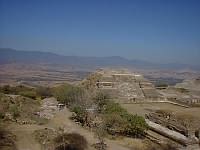 The next morning I visited Monte Alban, ruins of the ancient
capital of Zapotec culture from the 10th century. As with
Teotihuacan, it was an extensive and impressive site, with
numerous pyramids, ball courts, and temples. I rode to the
site on my bike. Free from the weight of my panniers, I
floated up the hill, climbing 10km in 36 minutes. Most visitors
came in large groups - the French, the Dutch, and the Germans.
At every historic site I visited, vendors would try and
sell their wares to passing tourists, and Monte Alban was
no exception. Fortunately, saying "no, gracias" a few times
would usually be sufficient to have them back down. Once
I informed one vendor that I didn't have any pesos left,
we sat down and chatted, discussing whether he would have
better luck going after the French, Dutch, or German group.
I argued for the Germans, but he opted for the French.
The next morning I visited Monte Alban, ruins of the ancient
capital of Zapotec culture from the 10th century. As with
Teotihuacan, it was an extensive and impressive site, with
numerous pyramids, ball courts, and temples. I rode to the
site on my bike. Free from the weight of my panniers, I
floated up the hill, climbing 10km in 36 minutes. Most visitors
came in large groups - the French, the Dutch, and the Germans.
At every historic site I visited, vendors would try and
sell their wares to passing tourists, and Monte Alban was
no exception. Fortunately, saying "no, gracias" a few times
would usually be sufficient to have them back down. Once
I informed one vendor that I didn't have any pesos left,
we sat down and chatted, discussing whether he would have
better luck going after the French, Dutch, or German group.
I argued for the Germans, but he opted for the French.
My mission for the afternoon was to figure out how to safely send my exposed
film back to the states for developing. For all my previous trips, I had just
lugged everything home, but 1) being on a long trip, 2) shooting much more
film, and 3) carrying everything by bike compelled me to find an alternative.
The previous day I carefully researched who would be able to safely and quickly
ship them for me. Having all my film lost in the Mexican post was my worst
nightmare. Thanks to the help of a local gentleman, we had found a company
called Dimex, which was able to send packages FedEx to the States. After
telling them what I wanted to do, they had assured me that it would be no
problem. So the next day I carefully wrapped up the film and headed to Dimex.
They wouldn't take it. Undeveloped film, they informed me, could contain
pornography or state secrets, and it was against the law to send it out of the
country. My efforts to convince them of the absurdity of their regulations
were fruitless. Their only advice was to try and find an older American couple
who were returning to the States to be a courier, since they woud pass through
customs without suspicion.
I headed to the most expensive hotel in town, the Camino Real. I described
my problem to the front desk, and they pointed me to a DHL office in town. DHL
took it no problem. They were placed in a sealed envelope with a tracking
number and everything. This was as secure as I was going to get.
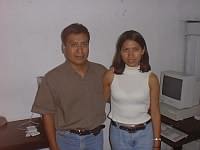 By this point, not only was I a regular at the internet cafe, but I was also a
regular at the food stall outside, which served fabulous Mexican pizzas -
toasted tortillas with avocados, cheese, tomatoes, and beans. The woman
cooking the food would usually run out of chorizo by the time I got there, so
she brought extra just for me. I went to the cafe to help the owner buy a
digital camera over the net. He was impressed enough with mine that he wanted
one of his own.
By this point, not only was I a regular at the internet cafe, but I was also a
regular at the food stall outside, which served fabulous Mexican pizzas -
toasted tortillas with avocados, cheese, tomatoes, and beans. The woman
cooking the food would usually run out of chorizo by the time I got there, so
she brought extra just for me. I went to the cafe to help the owner buy a
digital camera over the net. He was impressed enough with mine that he wanted
one of his own.
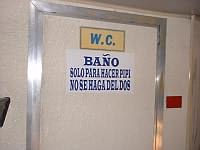 Having biked for the past week, it was time for a bus leg. I decided to go to
Palenque in the state of Chiapas, to see the Mayan ruins there. I missed an
earlier bus, so I passed a couple of hours in the bus terminal sorting through
all of my gear. The ride to Oaxaca taxed me significantly, so it was time to do
some serious jettisoning - lead camera bag, misc bikes tools, my second spare
tube, pages from my atlas that I didn't need, even the section of my map that I
no longer needed - all went in the trash. My hiking boots, polarfleece, South
American guidebook, and 220V battery charger would be sent ahead, my 2nd pair
of biking shorts, 3rd t-shirt, spanish grammer book, and just about everything
else non-essential (except for camera gear, of course) would be sent home. By
the time I had to head to the bus, I had designated about 15lbs as dead weight.
I learned a new word while loading the bus; desarmar(v) - to disassemble one's
bike into tiny pieces so that they're willing to cram it into the already full
storage area below the bus. By the time I had my handlebars off, they were
convinced that it would fit.
Having biked for the past week, it was time for a bus leg. I decided to go to
Palenque in the state of Chiapas, to see the Mayan ruins there. I missed an
earlier bus, so I passed a couple of hours in the bus terminal sorting through
all of my gear. The ride to Oaxaca taxed me significantly, so it was time to do
some serious jettisoning - lead camera bag, misc bikes tools, my second spare
tube, pages from my atlas that I didn't need, even the section of my map that I
no longer needed - all went in the trash. My hiking boots, polarfleece, South
American guidebook, and 220V battery charger would be sent ahead, my 2nd pair
of biking shorts, 3rd t-shirt, spanish grammer book, and just about everything
else non-essential (except for camera gear, of course) would be sent home. By
the time I had to head to the bus, I had designated about 15lbs as dead weight.
I learned a new word while loading the bus; desarmar(v) - to disassemble one's
bike into tiny pieces so that they're willing to cram it into the already full
storage area below the bus. By the time I had my handlebars off, they were
convinced that it would fit.
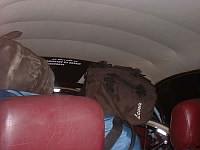 I was on a 2nd class bus, which meant no movie, broken seats, no bathroom,
and no rest stops - for 10 hours. There were probably a dozen people standing
the whole way - the person next to me kept joking that people should sit down
so he could see the movie. In order to get to Palenque I had to change buses
in Tuxla, the capital of Chiapas. I arrived at 4:30am, and the next bus left
at 5, but unfortunately it left from a station somewhere else in town. Not
having time to reassemble my bike and ride, I took a taxi - a VW bug. That's
right, I have now proven that it is possible to put a bike, 4 panniers, a
camera bag, and two people inside a VW bug.
I was on a 2nd class bus, which meant no movie, broken seats, no bathroom,
and no rest stops - for 10 hours. There were probably a dozen people standing
the whole way - the person next to me kept joking that people should sit down
so he could see the movie. In order to get to Palenque I had to change buses
in Tuxla, the capital of Chiapas. I arrived at 4:30am, and the next bus left
at 5, but unfortunately it left from a station somewhere else in town. Not
having time to reassemble my bike and ride, I took a taxi - a VW bug. That's
right, I have now proven that it is possible to put a bike, 4 panniers, a
camera bag, and two people inside a VW bug.
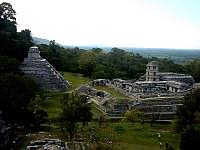 Palenque is an impressive ancient Mayan ruin site. The Mayans lived mostly
in the Yucatán penninsula of Mexico, in Belize, and in Guatemala. So this was
my best chance of seeing one of the major Mayan sites. The terain was
dramatically different from Oaxaca; rather than a high arid plain, the area
near Palenque contained sharp peaks covered with lush jungle.
Palenque is an impressive ancient Mayan ruin site. The Mayans lived mostly
in the Yucatán penninsula of Mexico, in Belize, and in Guatemala. So this was
my best chance of seeing one of the major Mayan sites. The terain was
dramatically different from Oaxaca; rather than a high arid plain, the area
near Palenque contained sharp peaks covered with lush jungle.
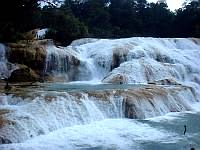 Since Palenque was a rather long sidetrip from my planed biking route, I took
the bus back to San Cristobal, stopping by the beautiful azure pools and
cascades of Aqua Azul. I tried to make it back to San Cristobal in one day,
but I just missed the connecting bus in Ocosingo, so I spent the night there.
It was a small, quiet town, but back in '94 it was one of the centers of
warefare in the Zapatista uprising.
Since Palenque was a rather long sidetrip from my planed biking route, I took
the bus back to San Cristobal, stopping by the beautiful azure pools and
cascades of Aqua Azul. I tried to make it back to San Cristobal in one day,
but I just missed the connecting bus in Ocosingo, so I spent the night there.
It was a small, quiet town, but back in '94 it was one of the centers of
warefare in the Zapatista uprising.
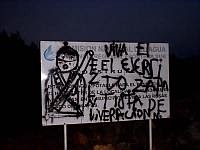 Ocosingo, as well as San Cristobal, are in the state of Chiapas, a region which
has many indiginous people. Descendents of the Mayan culture, many have
shunned the Spanish culture and maintained their own cultures and languages.
The region is very poor, however, and the Mexican government took away much of
their land. An uprising in '94 ended in a seize fire in '96. In '97 a group
of mostly women and children were massacred near San Cristobal. Numerous
governmental resignations followed. The area is stable now, but there is a huge
military presence. Everywhere I went there were jeeps full of kids of 19 or
20, toting machine guns. On my visit to Toniná (another ruin site outside
Ocosingo) I met a man from a local village. He gave me a little history of the
people of Chiapas and of the various ruins. He told me that when the
colonialists arrived from Europe, they would build churches on top of many of
the local temles, in order to coopt existing spiritual sites.
Ocosingo, as well as San Cristobal, are in the state of Chiapas, a region which
has many indiginous people. Descendents of the Mayan culture, many have
shunned the Spanish culture and maintained their own cultures and languages.
The region is very poor, however, and the Mexican government took away much of
their land. An uprising in '94 ended in a seize fire in '96. In '97 a group
of mostly women and children were massacred near San Cristobal. Numerous
governmental resignations followed. The area is stable now, but there is a huge
military presence. Everywhere I went there were jeeps full of kids of 19 or
20, toting machine guns. On my visit to Toniná (another ruin site outside
Ocosingo) I met a man from a local village. He gave me a little history of the
people of Chiapas and of the various ruins. He told me that when the
colonialists arrived from Europe, they would build churches on top of many of
the local temles, in order to coopt existing spiritual sites.
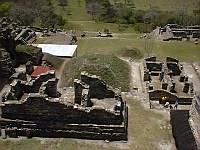 I finally managed to catch a bus back to San Cristobal. San Cristobal was a
lot like Oaxaca, seeing as it is part of the tourist circuit. For whatever
reason certain places, usually due to nearby attractions, become a regular
stop for travelers. As a result, the cities change to meet the needs of the
tourists. Upscale restaurants and shops crop up, along with tour agencies,
stores selling western goods, kids selling gum, and, of course, lots of
internet cafes. It wasn't a bad place to hang out, it's just that I was ready
to get moving again. But first I had to mail off all my excess baggage.
I finally managed to catch a bus back to San Cristobal. San Cristobal was a
lot like Oaxaca, seeing as it is part of the tourist circuit. For whatever
reason certain places, usually due to nearby attractions, become a regular
stop for travelers. As a result, the cities change to meet the needs of the
tourists. Upscale restaurants and shops crop up, along with tour agencies,
stores selling western goods, kids selling gum, and, of course, lots of
internet cafes. It wasn't a bad place to hang out, it's just that I was ready
to get moving again. But first I had to mail off all my excess baggage.
The post office, however, was closed, it being the anniversary of something
having to do with Benito Juárez. The post office was closed by 3 the day
before in Ocosingo, and it was closed the day before that since it was Sunday.
I was beginning to think that there really was no postal system, just a bunch
of signs in front of abandoned buildings. The post office, I was assured by a
man who was in the post office but apparently not working, would be open
mañana. Having played the mañana game with Carnaval, I was not about to play
again. I rode off anyway, with boxes of extra stuff strapped to the top of my
panniers. After a night of tuna fish and star gazing, I rolled into the next
town, Comitán. And much to my surprise, the post office was open. After a
trip to the stationary store to buy tape (the post office only sells stamps) I
went in with my boxes packed but not sealed (so they could make sure I wasn't
sending any rolls of pornography.) After a fairly long description that I
didn't completely understand, I realized that I needed to seal the boxes, then
cover them with paper. Back to the stationary store, then back to the sidewalk
outside the PO to wrap everything. When I was done with the 2nd of 3 boxes,
one postal worker walking by said something about getting a stamp from
someplace I didn't know the word for. After some clarification, I realized
that I had to take the packages to immigration to have them inspected and
sealed. If I didn't do this, the boxes would get opened up somewhere along the
line, and would probably never get closed again. The probelm was that the
immigration office was 7km out of town. I wasn't very excited about biking an
extra 15k just to satisfy Mexican bureacracy, so I paid a postal worker to
drive me over and chat with the immigration officer while I frantically
unwrapped and rewrapped the boxes. After barely looking in them, he stamped
them, and I was off to the PO again.
The boxes going to the states were fairly straight forward, but trying to
send the other things ahead was tricky. I didn't need the things until Peru;
however, post offices will only hold packages for a few weeks, and it took
anywhere from 1 month to 6 weeks to arrive. Consequently, there was really no
window when I could be guaranteed that the package would have arrived but
before it had been returned to sender.
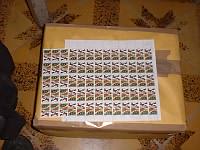 I decided to send it to Panama by airmail, which takes two weeks, since I had a
reasonable chace of arriving in Panama before they decided to give up on me and
ship it back. Unfortunately, this was expensive, costing 260 ps. For some
reason only Mexican postal officials would understand, they only had 4ps
stamps, so I needed 65 of them. By the time the postal worker was done dabbing
his sponge on all of them, teh entire back of the package had been covered with
stamps. Perhaps they should have just sold sheets of stamps to wrap the boxes
with.
I decided to send it to Panama by airmail, which takes two weeks, since I had a
reasonable chace of arriving in Panama before they decided to give up on me and
ship it back. Unfortunately, this was expensive, costing 260 ps. For some
reason only Mexican postal officials would understand, they only had 4ps
stamps, so I needed 65 of them. By the time the postal worker was done dabbing
his sponge on all of them, teh entire back of the package had been covered with
stamps. Perhaps they should have just sold sheets of stamps to wrap the boxes
with.
After three hours, the packages were off, and so was I. By the time 100k
rolled around, I was in the middle of nowhere, so I looked for a place to
sleep. I couldn't find anywhere good, so I slept 30ft from the highway, on top
of a bunch of thorny branches in a gulley. The spider presence was impressive,
with all sorts of varieties flocking to the light of my headlamp and trying to
join me in my bivy sack. Now what does a Brown Recluse look like again?
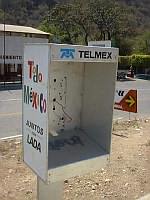 The next morning I realized I was closer to the border than expected, and I
rolled into the border town of Ciudad de Cuauhtémoc for lunch. I still had
70ps of time to use on my phone card, since I had not been able to locate a
single functioning phone for days. I walked up to the Telmex phone booths only
to find that they had all been ripped out. The only way to call the US was to
go to a Telmex shack down the road, scream the number to the near-deaf old man
working there, then dodge the baby chicks running all over the floor to get to
the phone booth in time to pick it up. 70ps down the drain. I spent my last
few pesos on some OJ, and a couple of tacos, then pedaled my was across the
border.
The next morning I realized I was closer to the border than expected, and I
rolled into the border town of Ciudad de Cuauhtémoc for lunch. I still had
70ps of time to use on my phone card, since I had not been able to locate a
single functioning phone for days. I walked up to the Telmex phone booths only
to find that they had all been ripped out. The only way to call the US was to
go to a Telmex shack down the road, scream the number to the near-deaf old man
working there, then dodge the baby chicks running all over the floor to get to
the phone booth in time to pick it up. 70ps down the drain. I spent my last
few pesos on some OJ, and a couple of tacos, then pedaled my was across the
border.

